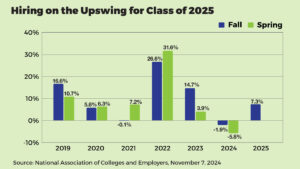Updated on May 25, 2023
Parenting is no easy task. Boy, is that an understatement! As a relatively new parent myself, I have a whole new perspective on the physical, emotional, and financial challenges of raising a child.
If you, too, have a child who seems to be growing up in the blink of an eye, here’s my advice to make the future at least a tiny bit easier: open a 529 Plan—now.
Why the urgency?
My daughter is barely in grade school, and I’m already getting a sinking feeling in the pit of my stomach when I think about the pending cost of college. And with good reason.
The average cost of a college education hit an all-time high in 2023, climbing to an almost unthinkable $157,000 for four years at a private, non-profit university. Add room and board to the equation, and you’re looking at another $50,000.
Even public schools charge a pretty hefty fee of just over $10,000 a year, on average, plus room and board.1 Those figures are enough to make any parent dizzy, and they’re expected to continue to climb at an alarming pace.
Thank goodness for 529 Plans. These government-regulated savings vehicles offer a tax-efficient way to start saving for your child’s future education. And because of the way the plans are structured, the sooner you can start saving, the better off you’ll be when that first college bill comes your way.
Here are 5 reasons 529 Plans are one of the most powerful savings tools around:
1) You don’t pay taxes on growth.
Assets in a 529 Plan grow tax-free, and you pay no taxes when you withdraw the money as long as you use the funds for ‘Qualified Educational Expenses’ (see section #2).
That means that when you add in the power of compounding to grow your investment over a decade or more, putting away as little as $50 or $100 each month can quickly add up to substantial savings that is earmarked solely for your child’s education.
2) You can use the funds for much more than just college tuition.
Many parents don’t realize that the funds in a 529 Plan can be used to pay for a variety of education-related costs, including room and board, books, laptops, and software required for school.
You can even use the funds to pay for K-12 tuition (up to $10k per year), and for trade or vocational school if your child decides traditional college isn’t the perfect path.
One other perk for later down the road: you can use a lifetime maximum of $10,000 from a 529 Plan to pay off student loans, too.
While the definition of these ‘Qualified Educational Expenses’ is quite broad, it is very important to keep careful records and to be sure you take distributions in the same calendar year that expenses are incurred. Otherwise, you risk having to pay taxes on the growth of the assets—plus a 10% penalty. That’s a situation you definitely want to avoid!
More savings smarts: Which Savings Account Is Right For My Financial Goals?
3) You can change the beneficiary at any time.
If your child is lucky enough to receive a scholarship (every parent’s dream!), or doesn’t use all of the assets in the fund, or doesn’t pursue higher education, you can change the beneficiary on the account to another child, yourself, or even your child’s immediate relative, such as a cousin.
And if none of those options make sense, you can save the fund to pay for the education of your future grandchildren, which gives the assets even more time to grow. That flexibility helps ensure the money you save is put to good use—even if it isn’t used by the original beneficiary.
Note: Gifting laws may affect the transfer of funds, so it’s always best to work with your financial advisor or CPA to be sure accounts are structured to your advantage.
4) Grandparents can contribute too.
Speaking of grandparents, they can be wonderful 529 savers too! The caveat: rather than having them write a check toward your own 529 Plan, ask them to open a separate account in their name, with your child as the beneficiary.
The money saved in an account the parent owns does impact your child’s FAFSA application, the federal form that determines student financial aid eligibility. But if a grandparent owns the 529, that money does not immediately affect financial aid determinations.
That said, once 529 assets are withdrawn for use for college expenses, they are included as student income on the following year’s FAFSA, which could have a negative impact on the student’s financial aid rewards.
That means that it may be best to set aside Grandma’s 529 Plan for the final year of college when the gift can no longer affect the FAFSA calculations. It’s a great way to boost your child’s savings without decreasing potential aid.
5) You may be able to receive a tax benefit when you contribute.
While you can’t deduct your contributions on your federal tax return, some states offer tax benefits on state income taxes. Every state is different, but here in Indiana, you can receive a 20% tax credit on up to $7,500 of contributions per year when you use the Indiana Plan.
This means that if you contribute $7,500 to your child’s Indiana 529 Plan, you will receive a $1,500 tax credit when you file your income tax return. That’s money that can be used for next year’s contributions!
Note: Most states offer a 529 Plan you can invest in regardless of where you or your child live, but to receive the tax credit you need to use the Indiana Plan and pay Indiana income taxes.
More savings smarts: 8 Ways to Save For College Tuition
Help Break The Student Loan Debt Cycle
Today, Americans owe more than $1.7 trillion in student loans, and Millennials (like me!) are carrying the majority of that massive amount of debt. According to a recent Bankrate study, 39% of Americans between age 35 and 49 are saddled with an average of $43,000 in student loan debt.
Now that we Millennials are having children of our own, it can be tough to even think about saving for our children’s education while we’re still struggling to pay off our own college loans. It’s a vicious cycle.
But just remember that putting away even a little bit each month can make a big difference during your child’s college years—and reducing student loan debt for the next generation may be the only way to finally break the cycle.
[1] Source: College Board, Annual Survey of Colleges; NCES, IPEDS Fall Enrollment data.







